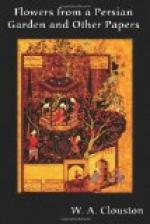It was no easy matter for Moses and his brother to gain access to Pharaoh, for his palace had 400 gates, 100 on each side; and before each gate stood no fewer than 60,000 tried warriors. Therefore the angel Gabriel introduced them by another way, and when Pharaoh beheld Moses and Aaron he demanded to know who had admitted them. He summoned the guards, and ordered some of them to be beaten and others to be put to death. But next day Moses and Aaron returned, and the guards, when called in, exclaimed: “These men are sorcerers, for they cannot have come in through any of the gates.” There were, however, much more formidable guardians of the royal palace: the 400 gates were guarded by bears, lions, and other ferocious beasts, who suffered no one to pass unless they were fed with flesh. But when Moses and Aaron came, they gathered about them, and licked the feet of the prophets, accompanying them to Pharaoh.—Readers who are familiar with the Thousand and One Nights and other Asiatic story-books will recollect many tales in which palaces are similarly guarded. In the spurious “Canterbury” Tale of Beryn (taken from the first part of the old French romance of the Chevalier Berinus), which has been re-edited for the Chaucer Society, the palace-garden of Duke Isope is guarded by eight necromancers who look like “abominabill wormys, enough to frighte the hertiest man on erth,” also by a white lion that had eaten five hundred men.
III
LEGENDS OF DAVID AND SOLOMON, ETC.
Muhammed, the great Arabian lawgiver, drew very largely from the rabbinical legends in his composition of the Kuran, every verse of which is considered by pious Muslims as a miracle, or wonder (ayet). The well-known story of the spider weaving its web over the mouth of the cave in which Muhammed and Abu Bekr had concealed themselves in their flight from Mecca to Medina was evidently borrowed from the Talmudic legend of David’s flight from the malevolence of Saul: Immediately after David had entered the cave of Adullam, a spider spun its web across the opening. His pursuers presently passing that way were about to search the cave; but perceiving the spider’s web, they naturally concluded that no one could have recently entered there, and thus was the future king of Israel preserved from Saul’s vengeance.




